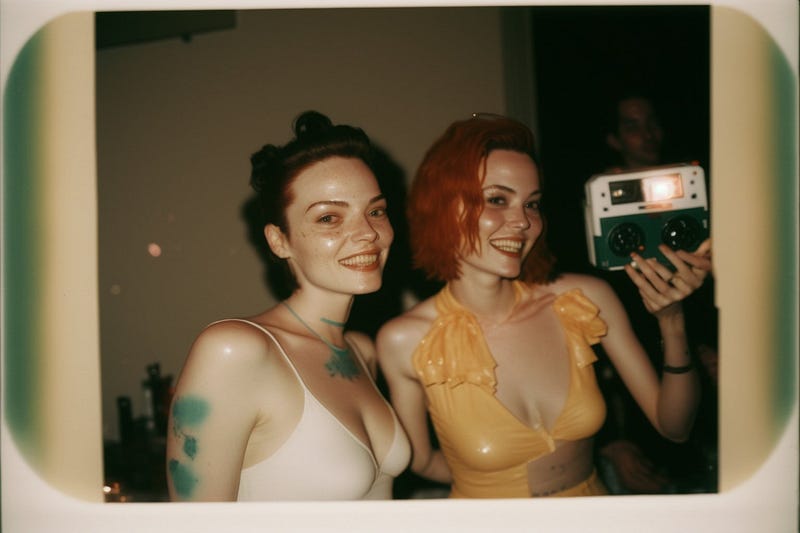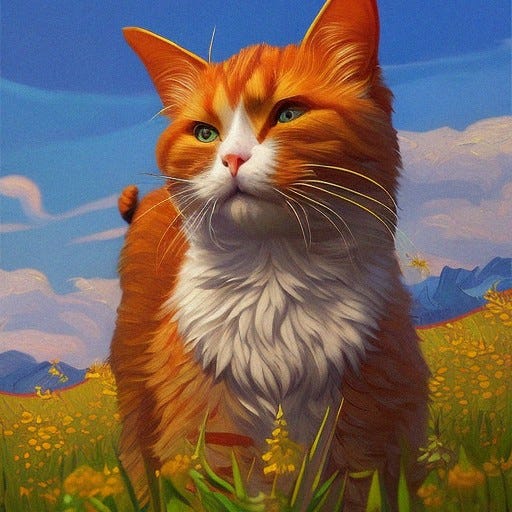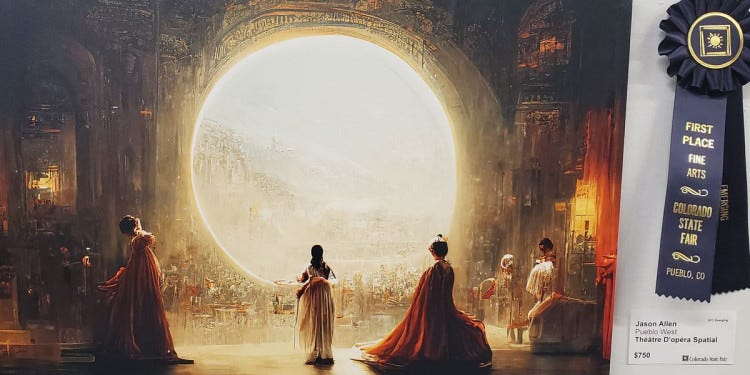Art by AI
What is AI generated Art?
What is AI generated Art?
Artificial Intelligence generated art is a new form of digital art sweeping the internet. The process of generating a piece of art using this method involves feeding an algorithm with data: this dataset includes completed art pieces made by human artists, and many reference photos of people, places, objects etc. If you yourself have ever uploaded a photo on the internet, there are high chances it has been used to train this AI. Based on the search made by the consumer, the AI will use the given dataset that it has trained from to create a digital image as closely related to the prompt as possible.
Oftentimes the results of these prompts are very accurate: depending on which algorithm is used, exact styles of famous artists can be easily replicated. For example, I asked a free AI generating art website, neural.love to generate a painting using the prompt: “Cat in a field in the style of Van Gogh”. Within a few minutes I was presented with not one, but four digital images that seemingly look like they could have been painted by Vincent Van Gogh.
AI Art is Theft
As previously discussed, the generated images cannot be created without an input- these being artworks and photographs. The ethical issue with this is that a majority of these images are copyrighted artwork or photographs taken from the internet without the consent of its rightful owners. Many instagram artists, both traditional and digital have become victims to this dishonourable process.
One artist being affected by the AI generation of art is Polish artist Greg Ruthkowski. Greg uses classical painting styles to create dreamy fantasy landscapes. He has produced illustrations for games such as Dungeons and Dragons, Magic: The Gathering, and many more. However, his iconic illustrative style and career is now being threatened by AI art. By simply searching prompts followed by “in the style of Greg Ruthkowsi’’ hundreds of images can be created which clearly resemble Ruthkowsi’s art to the slightest of detail. In its simplest form, AI art generation has the potential for reputation damage and identity theft.
Art in any form is subjective human expression. Many artists and creators spend their livelihoods refining techniques and styles, acquiring knowledge about different mediums, and using their creativity to produce something unique. Without AI generating art, it is already known that becoming a full time artist is formidable. Now with AI Art on the rise, the stakes for artists to make a living is even higher. Rather than paying a digital or traditional artist to commission work, consumers are able to use detailed prompts to instruct AI to create the exact image they want. Not only is this technology and software directly replicating years of practised technique by immorally sampling artwork, it is also taking the jobs of passionate and dedicated individuals.
To make matters worse, some algorithms tend to charge users for better quality art pieces or personalised digital portraits, much like the ones celebrities tend to post about. This means not only are these companies freely plagiarising artists, they also profit off of it. But, how do they get around “stealing” sources? The images and text descriptions used to feed the algorithm are taken from the internet through a process called Data Mining. Data Mining allows companies to gather excessive amounts of data while intentionally targeting legal loopholes. These legal loopholes weave through legal regulations put in place to protect artists. A popular AI Art generating company, Stability AI funded the largest dataset being used called LAION-5B. Containing 5.8 billion points of data, inclusive of copyrighted and private data, LAION-5B was created under the pretext of “research”. Quickly, the corporations behind the project turned the technology into a commercialised product now known as Dream Studio and Stable Diffusion, both owned by Stability AI.
What Artists Have to Say
Undoubtedly, artists have very strong opinions regarding art generated by AI, hashtags spread across platforms like Instagram and Twitter protesting a ban on AI Art. A digital artist I personally follow, by the name Feefal, once dedicated an Instagram post on the issue. Liked by over 160,000 accounts, her first hand experience of being an artist in today’s generation and having her career threatened was honestly what drove me to write this article. Feefal wrote:
“Deciding to be an artist for a living is honestly a pretty dumb decision. You get told by everyone it’s unrealistic, you’ll never be good enough, it’s not a real job etc. Still, you decide to try, you battle your negative thoughts daily as you start to second guess whether this path was meant for you — thinking of giving up several times. But you just can’t, it’s the only thing you want to do in life. So you need to be a little dumb to follow this path, otherwise you’d be blinded by reason.
When AI samples images from us without permission, they’re not just taking data. They’re taking a lifetime of dedication and putting it into a program, just to spit out some amalgamation of what is supposed to mimic human expression.”
A popular occurrence sparking debate and fury among the art community is the winner of the Colorado State Fair’s art competition of 2022. The winner of the competition, Jason M. Allen used Midjourney to turn lines of description into a hyper-realistic image. Many argued that his work was considered plagiarism due to the unethical practices of the technology. However, Allen claimed he did not mislead anyone about the origins of his art, submitting the piece with the name “Jason M. Allen via Midjourney”. Allen says “I’m not going to apologise for it. I won, and I didn’t break any rules.” Taken to social media, many are fuming with the decided winner and those defending the decision. Artists are expressing that writing keywords in a certain sequence to generate a photo is not art.
As a fellow creative myself, the thought of allowing AI to take over and redefine art hit too close to home. Drawing, painting and creating has always been a major part of my life. My art is an expression of how I feel and experience the world, providing me with satisfaction to see my progress and how I have changed as a person. Unfortunately, I am one of many who were discouraged from using my art as a profession rather than a hobby. My creative process and paintings come naturally, never feeling the need to hold back or be limited by my abilities. I am sure many of those reading this article feel the same: how much we care about art and how it has helped us develop. Art has been around for decades, documenting our origins and inspiring many. Why should we let inhumane software, plagiarising from other artists take over an instinctive practice that has been persistent since the beginning of time?
Future of AI Art and What We Can Do
Nevertheless, AI developed art will continue to improve and become more definitive. However, us artists and those who strongly empathise in the continuation of human made art, we can diminish the usage of AI generated Art.
DeviantArt is a highly used American online art community with over 38 million annual visitors. In 2022, the company opted to upload every art piece ever uploaded on the platform to their very own AI system. However, debates and protests made by many artists pushing back against the motive resulted in DeviantArt reversing the decision. This goes to show the power of our voices as a collective.
To stop AI from taking over the intricate world of art, it is our responsibility to share knowledge about how problematic AI art generation can be. Not only must we protect our current fellow artists, but the creators of our future generation. If we allow this technology to uninspire our growing artists, there will be no human emotion left in artistic expression.
[Written by: Nurrania Alfian. Edited by: Balvin Dhaliwal]







